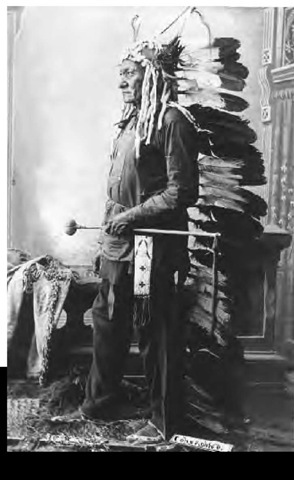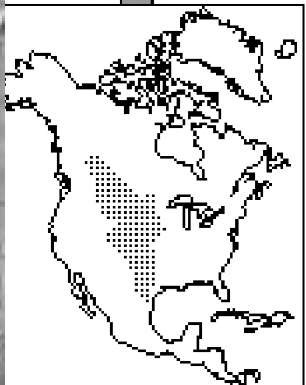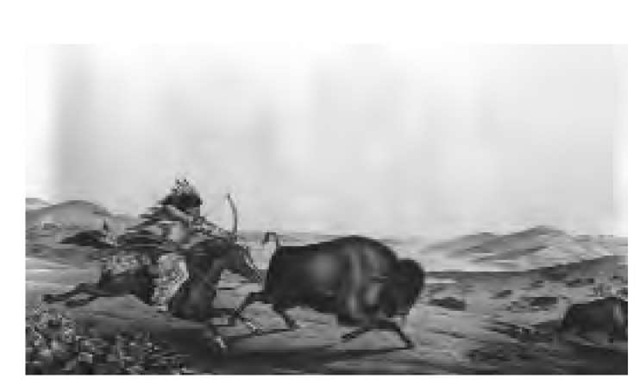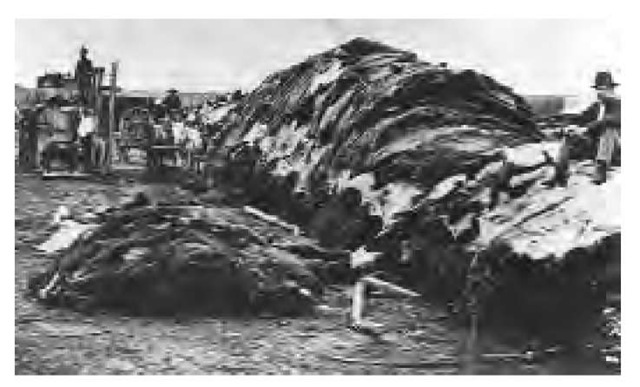Indians living on the Great Plains shared both a physical environment and, to a large degree, a lifestyle. Their natural resources changed relatively little from thousands of years ago until the late nineteenth century, when the great buffalo herds were destroyed. Wanton elimination of the roughly 30 million buffalo, in addition to millions more deer, antelope, and other game, brought an end to the Plains lifestyle as well, centered as it was, particularly after the various bands and tribes acquired horses, around the great, shaggy beasts.
The Great Plains is generally defined as a region of about 1.5 million square miles between the Mississippi River and the Rocky Mountains and from central Alberta and Saskatchewan to central Texas. The region’s greatest river is the Missouri, which is fed by tributary rivers and streams originating in the Rocky Mountains. The lower area between the Mississippi and roughly 100 degrees longitude constitutes prairie rather than true high plains, which in the west may range up to a mile or more in altitude. For comparative cultural purposes, however, the prairie region is usually discussed as part of the Great Plains.
Climatologically, the high plains is a relatively dry region—the average 15 inches of annual rainfall did not permit native agriculture as did the better-watered and more humid prairie. The plains’ generally flat terrain allows frigid polar air to enter the region in winter, whereas summers are often stiflingly hot. Dramatic weather events, from tornadoes and severe thunderstorms to blizzards, are regular occurrences. Grasses covered the region, shorter in the west and longer and more lush in the prairie.
In addition to grasses, cactus and sage grow in the western plains. Stands of trees, often willow, oak, box elder, and cottonwood, are found mostly in the river valleys. Scrub cedar and juniper dot prominent features like mesas and cliffs, whereas deciduous and coniferous trees grow in the lower Rockies. A number of wild vegetable plants and fruits also grew in the region.
The horse, which came from the Spanish settlements in the south and west, represented a foreign influence on Indians of the Great Plains. Other influences, such as guns, soon followed, and non-native diseases, which rivaled and perhaps exceeded the horse in changing Indian circumstances, stalked the people from the sixteenth century on. Thus non-Indian influences were indispensable to the "classic" phase of Plains Indian culture, which lasted for about 100 to 250 years. Despite heroic resistance, however, by the late nineteenth century that culture—and more—was gone. Yet, like many other Indians, descendants of the prehistoric inhabitants of the Great Plains are determined to survive and prosper as Native Americans in twenty-first-century America.
The first bands of hunter-gatherers moved onto the Great Plains perhaps 40,000 years ago. About 10,000 years ago, as the last ice sheets melted and the Plains became drier, grass began to cover the region. Ancient species such as the horse, camel, mammoth, and bison disappeared and were gradually replaced by smaller bison from Mexico. Hunters found and killed these animals in accustomed watering places, but they were not yet able to pursue them freely across the vast expanse of the Plains.
With the arrival of the horse in the late seventeenth to mid—eighteenth century, "classic" Plains Indian culture began to come into its own. This 1837 illustration shows a horseback hunt.
Early prehistoric people stored wild fruits and vegetables in underground caches, and some people began to grow a few crops. Vast networks that focused on the exchange of goods and complex religious practices operated on the Plains during the first millennium, centered in the Ohio Valley Adena-Hopewell culture. But as the region became ever drier and less hospitable, the nomadic bands slowly followed the game and the water eastward until, by perhaps 1200, the Plains were virtually empty of human habitation.
Shortly after this period, however, a moderation in weather conditions combined with severe drought in the Southwest led to the gradual repopulation of the Plains. The people were drawn in part by the presence of buffalo and other game and, at least in the beginning, by the possibility of settlement without conquest. Caddoan tribes in east Texas, such as the Pawnee, may have been among the first to reenter the Plains. Shortly thereafter, Athapaskan bands from northern Canada began migrating southward along the eastern Rockies.
With the exception of the Kiowa and Comanche, the Shoshonean-speaking peoples remained on the western fringes of the Plains in the seventeenth century. Some of the agricultural Siouan peoples, motivated partly by aggressive Iroquois expansion and the dynamics of the French fur trade, migrated west from the Ohio Valley to the Mississippi and Missouri Valley regions, reaching the high plains in successive waves between the sixteenth and the nineteenth centuries. Late in the 1700s they composed about half of the total population of the Great Plains. Finally, Algonquian-speaking Indians such as the Cheyennes and Blackfeet arrived from the east between the sixteenth and eighteenth centuries.
Before the horse transformed life on the Plains, dogs pulled the travois. Buffalo were generally killed by driving them over cliffs or surrounding them on foot and shooting into the confused mass of animals. Even later, buffalo and other animals might be killed in this way or, especially in winter, by individual stalking.
With the arrival of the horse, generally in the late seventeenth to mid-eighteenth century, "classic" Plains Indian culture began to come into its own. Horses allowed the people to acquire more food by traveling farther and faster after buffalo. Horse-drawn travois also increased overall mobility and thus people’s ability to follow the herds. Plains Indians soon became among the most skilled horsemen the world has ever seen. At their best, using only a modified halter, they could ride low enough over a horse’s flanks both to shield themselves while shooting their own arrows under the horse’s neck and to pick up fallen comrades on the fly. They also rode expertly in the midst of thundering buffalo herds.
At that time, there were three types of Indian groups on the Plains. Those like the Blackfeet had no agricultural traditions. Those like the Teton Dakota (Lakota) traded a farming life for that of the nomad, and those like the Mandan and the southern Siouans continued to grow crops while also hunting buffalo and other game.
The nomadic tribes generally lived in conical tipis that were relatively lightweight, easily manufactured from products of the hunt, and portable. Women sewed together between 6 and 18 buffalo skins and stretched them over a frame of poles. Tipis were about 14 feet high and about 14 feet in diameter on the ground and held on average between five and eight people. An adjustable smoke hole at the top kept the tipi free of smoke and well ventilated. The unfastened, east-facing seam at the front was the door. The bottom could be staked or weighted down or rolled up for increased air circulation.
Sacred places that mirrored the cosmos, tipis contained an interior stone altar for burning incense during prayers. In winter, they were insulated with pelts added to the walls. Since the wind most often blew from the west, tipis were also slanted slightly to the east to decrease overall wind pressure. Decorations might represent war exploits or visions.
People living in permanent or semi permanent villages also used tip is on the hunt but otherwise lived in square or rectangular (later circular) earth lodges holding up to 40 or more people. They depended to a greater or lesser degree on corn, beans, squash, and sunflowers, and some also grew tobacco. Among these people, scattered settlements gave way in time to more consolidated villages, located on high bluffs overlooking river valleys. These villages were often fortified by ditches and stockades. Both nomads and farmers ate large and small game such as buffalo, deer, elk, antelope, prairie chickens, and badgers, and most ate dogs, especially on special occasions. Some fished, and all gathered various wild nuts, fruits, and vegetables such as wild turnips and onions, gooseberries, and chokecherries.
Buffalo meat was eaten fresh or cut into strips, dried, and stored. Pemmican, consisting of cooked meat, fat, and berries, kept for months at least. Assuming that the buffalo herds were found during the autumn hunt, starvation was rarely a problem. Once the winter hit with its dangerous and unpredictable weather, the camp usually remained in a sheltered lowland location for up to five months. Horses could easily survive the winter on cottonwood bark.
Women made the clothing, generally from deer, mountain sheep, and/or buffalo skin. Tanning was an arduous process that consisted of stretching, scraping, treating (with a mixture of brains, fat, and other items), and soaking. Women wore a two-piece dress, with optional sleeves. For warmth, they also wore short leggings, moccasins, and buffalo robes. Men wore breechclouts and moccasins in warm weather, with a deerskin shirt, leggings, and a buffalo-hide robe in winter. Garments decorated with fringe and quillwork might reflect war honors. Plains Indians generally wore personal ornamentation such as necklaces and earrings made from bone, shell, hair, or feathers, as well as tattoos.
By 1900, non-Indians had deliberately and systematically destroyed the great buffalo herds. At this Dodge City, Kansas depot, 40,000 buffalo hides had been collected by one shipper alone (1885).
In addition to food, clothing, and shelter, the buffalo provided items such as bull-boats, parfleches, and other containers (hides and stomach); awls, hoes, and other tools (bones); rattles (hoof); bowstrings and thread (sinew); ropes and belts (hair); altars (skull); and spoons and cups (horn). The dried droppings even made excellent fuel. Other material items included saddles (although most people rode bareback) and riding gear, fish baskets and weirs, and elk antler or bone scrapers for tanning hides. Stone was also used as a raw material, particularly in earlier days. Plains Indians generally used two kinds of bow, a very fine one for buffalo hunting, and one for other purposes.
Plains Indians were noted for a wide-ranging artistic tradition. Ancient artifacts include birdstones and other items as early as 3000 B.C.E. and carved stone pipes as early as 700 C.E. More settled groups made pottery. Clothing and other items was decorated with porcupine-quill embroidery and, later, beadwork; both men and women painted leather goods such as tip is and parfleches.
For most Plains Indians, the circle was a sacred shape, the symbol of the interconnectedness of the universe. The sacred pipe, its bowl a circle, might be the property of one individual or the entire tribe. The use of a pipe in any kind of ceremony or agreement meant that an occasion was sacred and any associated vows or promises could not be broken. Sun and sky were foremost among a group of sacred natural beings and spirits known as Wakan Tanka, the Great Mystery.
Like many other Native Americans, Plains Indians also held vision quests, usually in a remote location and accompanied by personal deprivation. They took place only after purification in a sweat lodge and often at pivotal times, such as puberty or before war. Visions—also obtainable in dreams—were held to be direct communication with the world of sacred forces, which was considered ubiquitous. If successful, the vision quest resulted in the adoption of a guardian spirit.
Through their spirits, people received "medicine," or power, to be used in a variety of ways. Medicine often included certain behaviors, songs, and dances as well as the contents of a sacred bundle. Just as visions could benefit both individuals and the tribe as a whole, so also were medicine bundles the property of individuals or the entire tribe. Medicine bundles often conferred the power and the right to conduct a ceremony. They could be sold and the ceremonial rights transferred accordingly.
Although agricultural tribes conducted numerous ceremonies related to growing crops, the Sun Dance was the classic high plains Indian ceremony of the historic period. It originated during the early eighteenth century, although its antecedents predate that time. As the most important ceremony of the year, its purpose was to renew both nature and the well-being of the tribe. The dance was held in summer, when the various bands gathered for the communal buffalo hunt. During that period, the bands set up camp in a great circle, in which each band had a definite place and carefully proscribed behaviors. It was a time of socializing, courting, game playing, and generally reestablishing tribal unity.
Sponsored by a person seeking supernatural assistance, and led by a shaman, the Sun Dance itself lasted 12 days. Bands approached the Sun Dance circle over a four-day period. The four days following arrival of the bands was a time of ritual preparation. Marshals, children who would get their ears pierced, virginal female attendants, and people who obtained and prepared the Sacred Tree were all selected. This was a time of feasting and partying.
The ceremony itself took place over the following four days. It included mock battles with spirits, the "capture" and raising of the sacred tree and the mounting on it of a rawhide buffalo effigy, the erection of the sacred lodge, and sacred dancing and singing that included long periods of staring at the sun. As part of the ceremony, some tribes, such as the Teton Dakota, employed methods of self-torture, in which some participants implanted skewers in their chests or backs and danced until they ripped from the flesh. Other participants dragged buffalo skulls attached to skewers embedded in their chests around the field until the skewers ripped out. The purpose of the self-torture was to bring about visions for personal and tribal success.
Shamans, who were men and women possessing particularly powerful medicine, were intermediaries between the sacred and profane worlds. As such, they cured disease, helped people interpret their personal visions, and directed the hunt, since their powers were believed to influence both the herds and the hunters’ safety. In addition, some enjoyed varying degrees of political power. Shamanic priests, who received special training, played a key role in ceremonies.
With the necessities of life freely available, trade was not as well developed on the Plains as it was in some regions. Still, the development of a universal sign language greatly facilitated the exchange of goods, ideas, and information. Articles of the hunt were often exchanged for agricultural goods. Parfleches were a common item of trade, and even items from as far away as the Pacific Ocean (dentalium shells), the Great Lakes (copper), and the Gulf Coast (shells) were exchanged on the Plains. Two early trade centers were located at the Mandan and Arikara villages. After the seventeenth century, most trade items originated with non-natives. Chief among these (in addition to horses) were metal goods, guns, cloth, and beads.
Among the nomadic tribes especially, daring and bravery, particularly during the hunt and in raiding and war, were among the most important virtues. Military leadership was provided by a young man seeking glory. Plains Indian fighting was no less deadly than war ever is, yet warriors generally considered that the highest form of bravery was not killing an enemy but touching him, stealing his horse in a particularly daring way, or some other difficult and brave accomplishment. This custom was called counting coup, or war honors. Among most Plains tribes scalping, a custom that may have originated with the Spanish, did not merit a high war honor. Its importance lay primarily in representing the spiritual death of the victim.
War honors, which had to be publicly announced and accepted, were reflected in various articles of dress, such as feathers and types of shirt fringe. Eagle feathers symbolized the highest war honors. Warbonnets were worn only in parade, as a dress costume, with other highly decorated items. Shields, sacred by virtue of their designs, were normally kept covered.
The fundamental unit of Plains Indian society was the extended family. Bands or villages of variable constituency, composed of up to several hundred people of related families, formed the tribe. Some mostly semisedentary tribes also recognized clans and/or dual divisions. Bands only came together as a tribe in summer, when they united under a much more centralized political leadership to hunt, socialize, trade, raid, make war, and perform religious ceremonies. During these times, the camp police, composed of elite warrior societies, kept order and punished offenders, especially during the hunt. Among the nomadic peoples, bands often separated back into constituent families in winter.
Band and kin group chiefs, generally older men, had to have led lives characterized by generosity, bravery, proven ability in the hunt and in war, spiritual accomplishment, and honorable actions in every sphere. The position was honorific rather than authoritative. That is, the chief’s authority stemmed from his stature and lasted only as long as he could command respect. Each band often contained more than one chief. Among some semi sedentary tribes the chieftainship had hereditary elements. Bands were also led by a council of older men.
Men’s, women’s, and children’s cultural or military societies had their own particular ceremonies, songs, insignias, dances, and medicine bundles. Open societies, generally age graded, could be entered by anyone of the proper age who could purchase admission. Closed societies could only be entered by invitation. Societies were associated with different levels of status. Outside of the societies, status, which was generally fairly fluid on the Plains, might also be obtained by being a shaman or a berdache. In the case of semi sedentary groups, status also had a hereditary component.
Entry into womanhood was marked by isolation for several days while performing typical female work. A girl might acquire a vision during this time. If her parents could afford it, a feast and the distribution of gifts followed her seclusion. There were generally no formal puberty ceremonies for boys. A series of events, such as a boy’s first successful buffalo hunt, first war party, and certainly first vision quest, marked his passage to manhood. Marriages could be arranged as a union between families, but many were romantic, and many stories attest to sweet flute serenades and secret rendezvous.
Certain near relatives, such as other-sex siblings and in-laws, were generally avoided out of respect. In Plains Indian society there was always an obligation to provide for relatives; the extended family might number 30 people, each working to ensure the prosperity of the rest. Grandparents played a major role in culture transmittal and in day-to-day child rearing. Children were considered a blessing and were generally raised in what today might be considered a permissive manner. With the exception of the camp and hunt police, social order was generally maintained by peer pressure rather than any kind of systematic punishment. Early prehistoric traditions, particularly in the Ohio Valley, include mound burial. In later times, the dead were often buried in tree scaffolds or in the ground.
Even as the horse had transformed Plains Indian life, so disease epidemics—measles, influenza, and smallpox—decimated many Indian populations before the non-natives even arrived, thus setting up the "empty wilderness" that the latter came to covet. Beginning in the mid-nineteenth century, the presence of railroads and wagon trains disrupted the buffalo herds. Pioneers fought even friendly Indians. Their world under general attack, many of the warring tribes began to unite against the common enemy. Several major councils, particularly those at Fort Laramie in 1851 and 1868, produced treaties designed to strike a balance between Indian needs and non-native desires.
Later-nineteenth-century Plains Indian warfare retained its central role in ritual and status acquisition, but it also became a quest for survival and as such more brutal. Facing possible destruction and possessing superior horses and knowledge of the terrain, the Indians were successful at first. Ultimately, however, they were defeated by the sheer numbers of their opponents combined with their superior firepower.
The final "battle" took place on December 15, 1890, when U.S. soldiers wiped out up to 300 Indians, mostly women and children, at Wounded Knee, South Dakota. The massacre took place against the backdrop of the Ghost Dance, a new Indian religion that promised a return to a pre white Indian paradise. The government had feared it could reignite widespread military resistance.
By 1900, non-Indians had deliberately and systematically destroyed the great buffalo herds. They had confined Plains Indians to reservations and taken most of their land. The 1877 Dawes Severalty Act was another major land-grab scheme as well as a frontal attack against the tribal way of life. The act allotted tribal land to individuals, the "surplus" (91 million acres total in the United States) to be opened to non-native purchase. Later, thousands of Indians lost their allotments through tax default.
Through missionaries, the government began a full-scale assault on Indian culture. Their means of subsistence gone and their traditional leaders killed or undermined, Plains Indians went into a long period of extreme transition. Their situation became characterized by dependence and poverty. In Canada, Plains Indians were forced to take up farming but were denied decent land, land ownership, credit, and even, without the permission of the government bureaucracy, the right to sell their produce.
Plains Indians in the United States were under similar pressures and faced similar difficulties. Furthermore, at least among the former nomads, agriculture was for a long time considered socially unacceptable. Plains Indians were individualists, but their ethic of generosity frustrated the efforts of government officials determined to make them more selfish. Toward this end, the government began removing Indian children, often by force, from the family environment and shipping them to violent, culture-killing boarding schools. Early in the twentieth century, the Peyote religion (Native American Church), with its origins in Mexico, became popular among several Plains Indian groups.
In the 1930s, the Dawes Act was superseded by the Wheeler-Howard Act, also known as the Indian Reorganization Act (IRA). Among other provisions, the IRA allowed Indians to set up constitutional governments. Although allowing Indians to deal government-to-government with the United States, the act also further undermined the traditional political structure. In the 1950s, the federal "termination" policy was designed to abrogate all treaties unilaterally. Also in the 1950s, the government again got into the business of forcibly relocating Indians, this time from reservations to urban centers. Ostensibly done in order to enhance economic opportunity, the result of this policy was the alienation of large numbers of Indians in urban ghettos and their permanent loss to the reservation community.
Policies of the "self-determination" era of the 1960s and 1970s, combined with Great Society antipoverty programs, helped Plains Indians begin to pull away from chronic poverty. This era also saw renewed Indian activism. The American Indian Movement (AIM) encouraged Indians to throw off internal corruption while holding the federal government to its trust obligations. Several tribal colleges were begun. However, renewed funding cutbacks in the 1980s and 1990s negated some of these gains. Despite the rise of casino gambling on several reservations, poverty continues to stalk many Plains Indian communities. Most Indian reservations suffer from a lack of capital, and, with few exceptions, economic development remains an elusive goal.
Although Plains Indians have assimilated in varying degrees to mainstream society, many continue to lead lives deeply rooted in their cultural and spiritual traditions. Reservation life, although economically difficult, provides a vital focus for these activities. Many native Plains languages are in regular use. The Sun Dance, once banned with other "heathen" ceremonies, has reemerged in a modified version. Giveaways, traditional healing and other ceremonies, and art, craft, and aesthetic traditions remain very much alive and vital. The refusal of some tribes to sell the Black Hills for any price (the current offer is over $200 million) symbolizes the unyielding regard for and the enduring place of their heritage in the lives of Plains Indians today.




